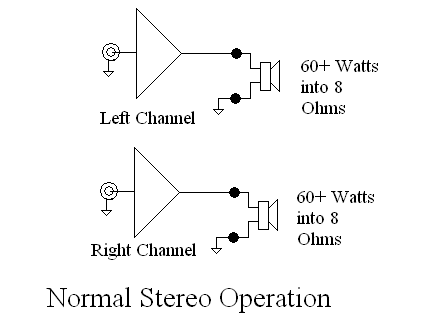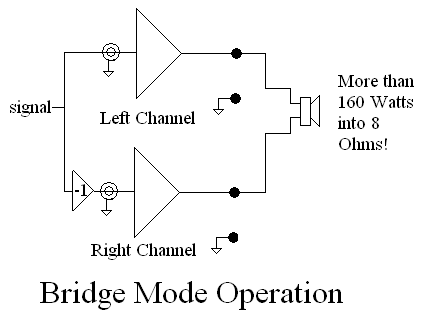
A funny thing happened on the way to making a set of modification directions that would easily and inexpensively let you configure your Stereo 120 with updatemydynaco modules for bridge mode operation. I learned a bit more about the LM3886 and its SOA (safe operating area) protection circuits. While at 1 kHz, they let the LM3886 put out incredible power, e.g. more than 100 Watts into 4 Ohms, they prevent delivering that power for long much below 100 Hz. It still does a great job into an 8 Ohm load, but for a 4 Ohm load, it really won't put the low frequency power out for long.
What does this mean? You can still modify it for Bridge Mode operation, and upon doing so, instead of 2 channels of 60 watts each into 8 Ohms, you'll get:
The conclusion is this...Bridging doesn't make quite the beast I once believed. Still, I wrote some nice modification directions, so I'll post them, but unless you have 16 Ohm speakers, bridging mode is of limited value.

Modified with the UpdateMyDynaco Kit, the Stereo 120 puts more than 60 Watts into 8 Ohms before clipping. Into 4 Ohms, a single channel will do well over 100 Watts. You're probably already familiar with the normal operating mode.

In bridging mode, you drive the channels out of phase, and connect the speak between the two red binding posts. We made a quick test of the bridging connection...it turns the Stereo 120 into a single channel amplifier capable of 160 clean Watts into 8 Ohms!!! If you have a pair of Stereo 120's, you can have 320 Watt Stereo Amp. That is serious power!
There are two modifications required:
The first change allows the power supply to put out a lot more current, enabling the higher output power. The second change makes it easy to convert a stereo amp to a mono bridged amp for the cost of 1 resistor and a wire. Click here to download the details of that change.
The bridge connection doubles the output voltage. Power goes as the square of the output voltage, so in the limiting case, the bridging connection could provide 4 times the output power. That would turn 60 Watts into 240 Watts. Some practical limits get in the way. 240 Watts is twice the rated power of the original amplifier. That means that even if the amplifier modules could deliver 2X the power, the power supply would also need to deliver twice the power. It turns out that the power transformer gives up, and the raw rectified output voltage sinks below 70 Volts when you try to deliver 200+ Watts. In addition, as we noted in the opening, the SOA limiting circuits don't allow high power to be delivered below 100 Hz for very long. At first, things look encouraging, but as the heat sinks warm up, the SOA limit kicks in, and the power drops.
The issue is that a bridge tied 8 Ohm load looks like a 4 Ohm load to each amp. While the amps will happily deliver 60 Watts per channel into 8 Ohms all day long, even with dreadfully hot heatsinks, they shy away from the heroics of 100+ Watts into 4 Ohms after a short time. The good news however, is that you can beat the heck out of the amps, and the protection circuits rein things in before any damage can occur.
If you have a pair of Dynaco Stereo 120s converted with the UpdateMyDynaco new amplifier modules and super heat sinks, and you convert it for bridge mode operation, you can:
Except for these special cases, I would probably recommend against the bridging configuration.